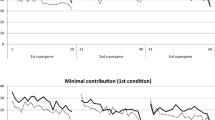Abstract
Simultaneous moves have been conventionally assumed in modeling rent-seeking competition. However, in reality many forms of contests involve contestants sequentially choosing their effort entries. This study allows agents to choose the timing of their moves before the contest takes place. In contrast to the previous literature, we introduce information asymmetries across agents. We find that in all sequential-move equilibria, the uninformed agent moves first. More generally we show that the order of agents’ moves in a sequential contest is a regularity stemming from information asymmetries. Furthermore, under plausible assumptions, sequential moves Pareto dominate simultaneous moves (from the view point of the players) and also result in lower rent-seeking expenditures. Our result explains the timing pattern in National Presidential Conventions observed from 1948 through 2004. Our result also applies to many other formal or informal institutions, which give rise to sequential contests.
Similar content being viewed by others
References
Bernado, A., Talley, E., & Welch, I. (2000). A theory of legal presumptions. Journal of Law, Economics, and Organizations, 16, 1–49.
Baye, M., Kovenock, D., & de Vries, C. (1998). A General Linear Model of Contests, working paper Indiana University.
Fu, Q. (2005). Litigation, Settlement, and Legal Presumption, working paper, Indiana University and National University of Singapore.
Hurley, T., & Shogren, J. (1998). Effort levels in a cournot nash contest with asymmetric information. Journal of Public Economics, 69, 195–210.
Leininger, W. (1993). More efficient rent-seeking –a Mü nchhausen solution. Public Choice, 433–462.
Kreps, D., & Wilson, R. (1982). Sequential equilibria. Econometrica, 50, 863–894.
Morgan, J. (2003). Sequential contests. Public choice, 116, 1–18.
Skaperdas, S. (1996). Contest success functions. Economic Theory, 7, 283–290.
Wärneryd, K. (2003). Information in conflicts. Journal of Economic Theory, 110, 121–136.
Author information
Authors and Affiliations
Corresponding author
Additional information
JEL Classifications: H1, C7, D8
Rights and permissions
About this article
Cite this article
Fu, Q. Endogenous timing of contest with asymmetric information. Public Choice 129, 1–23 (2006). https://doi.org/10.1007/s11127-006-8325-8
Received:
Accepted:
Published:
Issue Date:
DOI: https://doi.org/10.1007/s11127-006-8325-8




